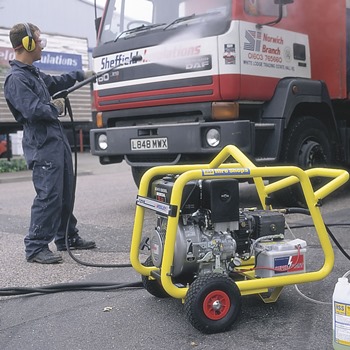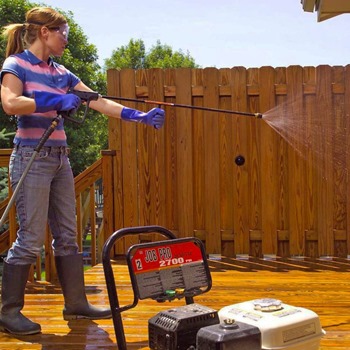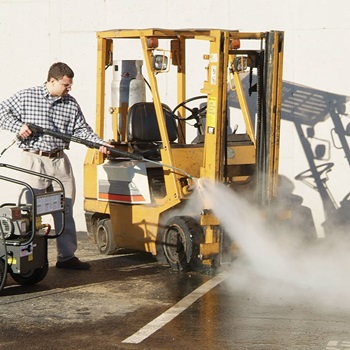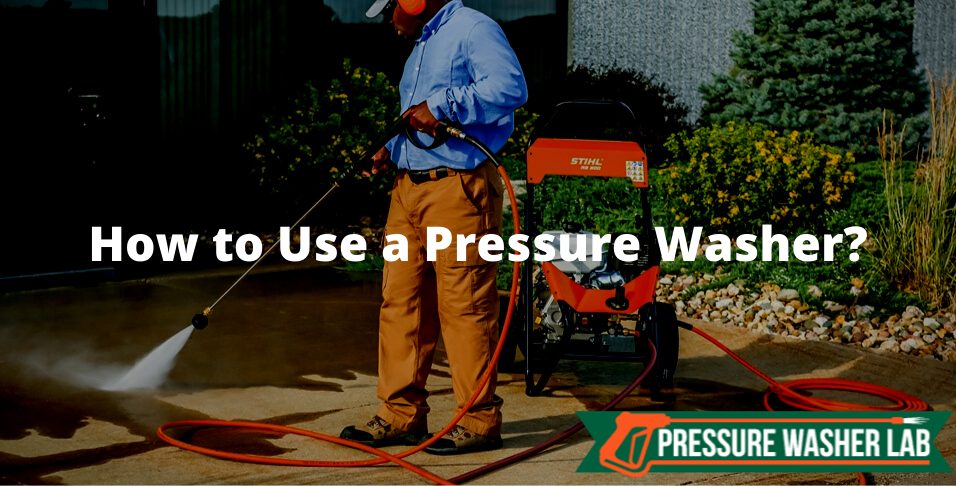Using a pressure washer can be done by taking the following steps:
- Prepare the surface that needs to be cleaned, set up and inspect the pressure washer before use, and put on protective gear.
- Connect the pressure washer to a water supply.
- Turn on the power washer.
- Pressure clean the area by adjusting the pressure of the unit, using the right nozzles, directing the trigger gun accordingly, using soap or a foam cannon if needed, and adjusting the water temperature in case a hot water pressure washer is used.
- Stop the pressure washer.
- Prepare the pressure washer for storage.
How to prepare for a pressure cleaning job and all the information needed on how to use a power washer, together with useful tips, are discussed in detail below.
Pressure Washing – Tips To Consider Before Starting A Cleaning Task
Put Protective Gear On Before Starting A Pressure Washing Task
 Wearing protective gear while using a pressure washer is recommended by all manufacturers because a power washer can become dangerous if not used properly. The protective gear consists of safety goggles and thermal protective gloves in case a hot water pressure washer is used.
Wearing protective gear while using a pressure washer is recommended by all manufacturers because a power washer can become dangerous if not used properly. The protective gear consists of safety goggles and thermal protective gloves in case a hot water pressure washer is used.
While using a pressure cleaner, wearing non-skid footwear is highly indicated to eliminate the risk of injury. Wearing neckties, loose clothing, jewelry, or loose long hair is not recommended because they could get stuck into the moving parts of the cleaning unit.
Prepare The Surface For Pressure Washing
The area that needs to be cleaned using a power washer has to be released from plants, toys, bikes, and other items that could get damaged when coming in contact with pressure water. The plants in the nearby area can be covered with a tarp. Removing rocks, needles, and debris using a broom is recommended to avoid injury, as these small pieces can be propelled at extremely high speeds if they are exposed to high pressure.
Set Up The Pressure Washer
Setting up the power washer requires connecting all the essential accessories such as the pressure washer hose attachment, the spray gun, the wand, and the nozzle tip. Pressure washer manufacturers such as Karcher, Simpson, Sun Joe, Ryobi, Generac, and Greenworks have clear instructions on how to do this in the user manual of every pressure washer model. This process is detailed in the first section of our article on how to start a pressure washer.
Inspect The Pressure Washer Before Use
A pressure cleaner can get damaged if it is not used under proper conditions. These conditions require all the components of the unit to work properly. Before every use, inspect the connections to see if they are properly secured. Making sure that the power washer tips are clean and that the garden hose and the high-pressure hose are not clogged is also required to avoid damaging the unit during use.
Before operating a gas pressure washer, checking the oil levels for the engine and pump is highly recommended. Ensuring that the gas tank has enough clean fuel should also be done before every use. Operating a power washer without enough oil or fuel could lead to severe damage that is not covered by any of the pressure washer warranties.
Pressure Washing Steps
1. Connect The Power Washer To A Water Supply
All pressure washers need to be connected to a water source using a garden hose. This hose needs to first be attached to the water supply and rinsed until the water stream is consistent. After turning off the water supply, the garden hose can be attached to the pressure washer through the water intake fitting.
Portable pressure washers that work on batteries are usually supplied with a water tank, as they are designed for increased mobility and can be used even if the operator doesn’t have a water source in his proximity.
2. Start The Pressure Washer
Starting a pressure cleaning unit needs to be performed differently for electric power washer models and gas-powered units. An electric pressure washer needs to be connected to an outdoor outlet and turned on using a start switch. A gas power washer, on the other hand, requires the operator to pull a cord or a handle to turn on the engine. Our article on how to start a pressure washer describes this process in detail.
3. Pressure Wash The Area
 Before performing certain operations with a pressure washer, the operator needs to have information about the steps required to operate a trigger gun, to use a nozzle, to adjust the pressure, to use detergents, or to use other attachments, such as foam cannons. This information is discussed in detail below.
Before performing certain operations with a pressure washer, the operator needs to have information about the steps required to operate a trigger gun, to use a nozzle, to adjust the pressure, to use detergents, or to use other attachments, such as foam cannons. This information is discussed in detail below.
3.1. How To Use A Pressure Washer Gun?
A pressure washer gun trigger is easy to use, as the only thing it does is to communicate to the unit that water needs to be sprayed out. To do this, the operator has to press the trigger. When the trigger of the gun is released, the water spray will stop.
Most modern power washer spray guns are equipped with quick-connect fittings, which makes them really easy to attach to a high-pressure hose. On the side where the water comes out, the trigger gun is equipped with a fitting that accommodates a power washer tip or a wand. This fitting is usually quick-connect also.
A pressure washer spray gun should always be secured when it is not operated to prevent injuries. Most power washer guns are equipped with safety-lock mechanisms that prevent unwanted operation. This feature also reduces energy and water consumption.
3.2. How To Use Pressure Washer Nozzles?
Power washer nozzle tips don’t require any tools for installation, as a twist is all the operator needs to perform to attach them to a pressure washer wand or gun. Don’t forget to pull back the quick-connect coupler of the wand or of the gun before inserting the nozzle.
Pressure washer nozzles come in different colors that indicate what they are suited for. Not all nozzles are suited for every task. Using a red nozzle tip to clean a window, for example, will most certainly break it. More information on how to choose the right power washer nozzle is available on our website.
When changing the nozzle on a pressure washer make sure that the unit is turned off. Always check that the power washer tips are completely secured before operating the unit, as flying objects that are propelled by high pressure could cause severe injury. If the pressure washer is not spraying hard it might be because the nozzle tip is not installed, this is why checking the trigger gun before use is recommended.
3.3. How To Choose The Right Pressure Rate On A Power Washer?
Choosing the right pressure for a cleaning task is easy as long as the toughness of the cleaned surface is considered. Surfaces such as concrete are rough and can withstand higher pressure but surfaces that are painted or are fragile, require the use of low pressure. Pressure washing cars, for example, can be tricky because they are painted and have windows and mirrors, therefore choosing a really high pressure to remove the dirt is not appropriate.
Adjusting the pressure of a power washer can be done by controlling the distance at which the machine is operated. When the unit is operated really close to the cleaned area, the pressure is high. When the distance is larger, the pressure is lower. Using the right pressure washer nozzle is also a means for adjusting the pressure. The white nozzle, for example, has the lowest pressure of all because it directs the water spray to a 40-degree angle.
3.4. How To Use Soap With A Pressure Washer?
Pressure washing different types of surfaces ask for different pressure rates. Some surfaces are stained or covered in tough-to-remove dirt that requires the use of chemicals. Other types of surfaces are fragile and very high-pressure levels might deteriorate them. The use of a pressure washer detergent is needed to perform thorough cleaning.
Pressure washer soaps and detergents can be used both if the unit is equipped with a detergent tank or not. Some power washer chemicals need to be diluted, others have ready-to-use formulas. Before pouring the cleaning solution into the soap tank, make sure the concentrations are appropriate, otherwise, the unit might get damaged.
The chemical siphon hose attached to the power washer needs to be inserted into the internal or external soap tank. Using chemicals with a pressure washer requires the use of a black nozzle that works at low pressure. Make sure to stop the unit before you change the nozzle.
Some power washers are equipped with chemical control valves that can be adjusted to release more or less detergent, according to the operators’ needs. The user manual of each pressure washer model has clear instructions on how these valves work. Turning the valve counterclockwise usually increases the quantity of soap released but some units work differently.
3.5. How To Use A Pressure Washer With A Foam Cannon?
Foam cannons are used with pressure washers to create thick foam layers that provide deep cleaning. Attaching a foam cannon to a power washer can be done in seconds, as the user has to attach it to the end of the pressure washer wand. Foam cannons require special detergents that need to be poured inside their container. Foam cannon soaps have a formula that allows them to create bubbles quicker than other types of detergents.
After attaching the foam cannon to the wand or gun and inserting the detergent, the quickest way to create studs is to set the pressure washer on the maximum pressure level and start cleaning. Depending on the model, foam cannons have adjustment systems that allow the operator to either regulate the flow or the soap rates to customize the cleaning process according to the surface that is being cleaned.
3.5. How To Use Hot Water On A Pressure Washer?
 When using a cold water pressure washer, which is what most residential users own, the maximum water temperature that is allowed to go through the unit is 40 degrees Fahrenheit. Anything above that can damage the components of the power washer, as they are not heat protected.
When using a cold water pressure washer, which is what most residential users own, the maximum water temperature that is allowed to go through the unit is 40 degrees Fahrenheit. Anything above that can damage the components of the power washer, as they are not heat protected.
The use of warm or hot water is allowed only when operating a hot water pressure washer. Some hot water units allow for the water that comes through the external water supply to be hot, others heat the water themselves. These units clean various areas by using cold or hot water, therefore the temperature can be adjusted according to the user’s needs.
To heat the water used by a pressure washer, the burner switch needs to be moved to the ‘On’ position only after releasing the trigger of the gun. Most hot water pressure washers are supplied with a temperature control system that allows the operator to set the temperature needed for a specific cleaning task.
When the pressure washer trigger is pressed, the burner and the water flow will start and when the trigger is released, both will stop. If the burner doesn’t stop, turn off the unit and don’t use it until it is serviced.
3.6. Pressure Cleaning Tips
- Never touch the pressure washer nozzle or place hands in front of the sprayer while the unit is in use.
- Don’t touch the pressure washer cord or the outlet with wet hands.
- Don’t use a pressure washer under the influence of alcohol or drugs.
- Disconnect the high-pressure hose only after the cord is disconnected from the power source.
- Do not use a gas pressure washer indoors, as it can lead to intoxication.
- Always read the power washer user manual before the first use.
- Don’t use bleach inside a pressure washer because it will damage the unit.
- Don’t put the wand down when the pressure washer is still running.
- Keep people and pets away from the cleaned area, as they could get hurt during the process. If this is not possible, avoid pointing the gun at them to eliminate the risk of severe injury.
4. Stop The Pressure Washer
To turn off a power washer, the operator needs to release the trigger. In case of hot water use, after moving the burner switch to the ‘Off’ position, press the trigger until the water coming out of the unit is cold.
If chemicals have been used during the cleaning process, the detergent hose needs to be placed inside a tank full of clean water which has to be run through the system until there is no chemical residue left. Turn on the motor or the engine of the unit. Do the same for the water source. Press the trigger to get all water out of the system.
5. Prepare The Pressure Washer For Storage
Preparing a pressure washer for storage is recommended after every use, as improper storage could lead to damage. To expand the lifespan of a pressure washer, all accessories, such as the nozzles and hose need to be cleaned so that they will remain like this for the next cleaning task.
The pressure washer attachments have to be detached from the machine after all the water has been removed from the hoses, the detergent tank, and the pump. The water inside the pressure washer can lead to freezing damage if the unit is not stored properly at low temperatures. More details about storing a power washer during the winter can be found in our article ‘How to winterize a pressure washer’.

